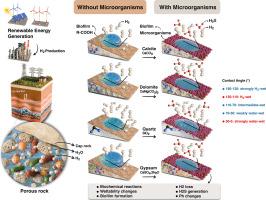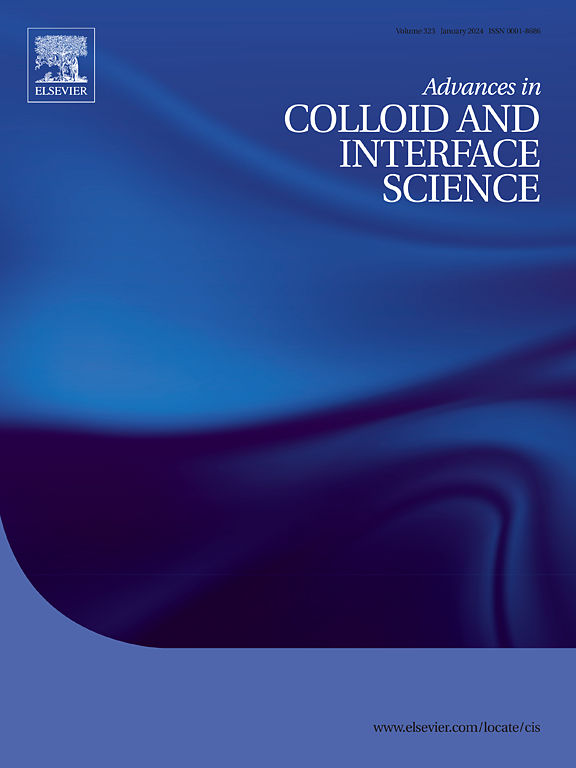The Microbial Factor in Subsurface Hydrogen behavior: Implications for Wettability and Interfacial Dynamics
IF 19.3
1区 化学
Q1 CHEMISTRY, PHYSICAL
引用次数: 0
Abstract
Microbial activity plays a significant role in subsurface hydrogen behavior, with implications for underground storage and natural hydrogen systems. This study examines how microbial processes influence the wettability and solid–liquid interfacial characteristics of key subsurface minerals, calcite, dolomite, quartz, and gypsum, in hydrogen-brine-rock systems under realistic subsurface conditions. Wettability directly affects hydrogen distribution, flow dynamics, and trapping, making it a critical factor for both storage and natural recovery applications. Experiments were conducted under high-pressure, high-temperature conditions, with SEM/EDS analysis used to characterize interfacial modifications and mineral surface changes across three scenarios: clean, organic acid-aged, and microbial-aged. Microbial aging consistently increased mineral hydrophilicity, reducing advancing contact angles, such as from 57° (clean) to 40° (microbial-aged) on calcite at 50 °C and 8 MPa. Similar trends were observed for dolomite, with smaller changes for quartz and gypsum. Microbial biofilms were most prominent on calcite and dolomite surfaces, accompanied by decreases in brine pH (e.g., from 7.4 to 5.2 for calcite). These results reveal how microbial processes reshape mineral properties and hydrogen behavior in the subsurface. This study provides critical insights into microbial-mineral interactions, offering valuable guidance for optimizing hydrogen storage and natural hydrogen recovery systems.

地下氢行为中的微生物因素:对润湿性和界面动力学的影响
微生物活动在地下氢行为中起着重要作用,对地下储存和天然氢系统具有重要意义。本研究考察了在真实的地下条件下,微生物过程如何影响氢-盐水-岩石系统中关键地下矿物方解石、白云石、石英和石膏的润湿性和固液界面特征。润湿性直接影响氢气分布、流动动力学和捕集,使其成为存储和自然采收应用的关键因素。实验在高压、高温条件下进行,利用SEM/EDS分析表征了三种情况下的界面修饰和矿物表面变化:清洁、有机酸老化和微生物老化。微生物老化持续增加矿物的亲水性,降低推进接触角,例如在50°C和8 MPa下方解石上从57°(清洁)到40°(微生物老化)。白云石也有类似的趋势,石英和石膏的变化较小。微生物生物膜在方解石和白云石表面最为突出,并伴随着盐水pH值的降低(例如,方解石从7.4降至5.2)。这些结果揭示了微生物过程如何重塑地下矿物性质和氢的行为。这项研究为微生物与矿物的相互作用提供了重要的见解,为优化氢储存和天然氢回收系统提供了有价值的指导。
本文章由计算机程序翻译,如有差异,请以英文原文为准。
求助全文
约1分钟内获得全文
求助全文
来源期刊
CiteScore
28.50
自引率
2.60%
发文量
175
审稿时长
31 days
期刊介绍:
"Advances in Colloid and Interface Science" is an international journal that focuses on experimental and theoretical developments in interfacial and colloidal phenomena. The journal covers a wide range of disciplines including biology, chemistry, physics, and technology.
The journal accepts review articles on any topic within the scope of colloid and interface science. These articles should provide an in-depth analysis of the subject matter, offering a critical review of the current state of the field. The author's informed opinion on the topic should also be included. The manuscript should compare and contrast ideas found in the reviewed literature and address the limitations of these ideas.
Typically, the articles published in this journal are written by recognized experts in the field.

 求助内容:
求助内容: 应助结果提醒方式:
应助结果提醒方式:


